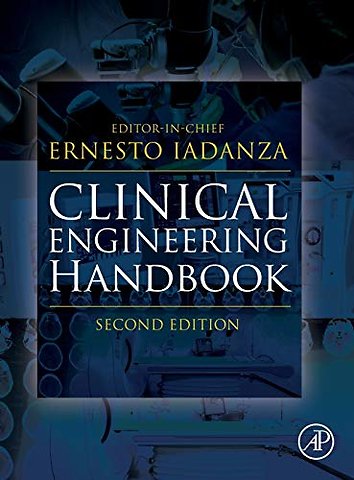<p>Section 1 Clinical Engineering <br>Section 1 Overview<br>1. Clinical Engineering:<br>2. Open Source Medical Devices: Healthcare Solutions for Low- and High- Resource Settings<br>3. Success Stories in Clinical Engineering<br>4. RFID technology in healthcare<br>5. Computer Aided Facilities Management<br>6. Public Procurement Of Innovative Medical Technology: Femtosecond And Excimer Laser Platform For Ophthalmic Surgery</p> <p>Section 2 Worldwide Clinical Engineering Practice <br>Section 2 Overview<br>7. Clinical Engineering in the United Kingdom<br>8. Clinical Engineering in Canada<br>9. Clinical Engineering in Colombia<br>10. Clinical Engineering in Mexico<br>11. Clinical Engineering in Paraguay<br>12. Clinical Engineering in Peru<br>13. Clinical Engineering in Venezuela<br>14. Clinical Engineering in Japan<br>15. Clinical Engineering in Brazil<br>16. Clinical Engineering in the Middle East<br>17. Clinical Engineering in China<br>18. Clinical Engineering in Argentina<br>19. Clinical Engineering in Italy<br>20. Clinical Engineering in India<br>21. Clinical Engineering in Poland<br>22. Clinical Engineering in Australia<br>23. Clinical Engineering in Chile<br>24. Clinical Engineering in USA<br>25. Clinical Engineering in Albania<br>26. Clinical Engineering in South Africa<br>27. Clinical Engineering in Uganda</p> <p>Section 3 Health Technology Management <br>Section 3 Overview<br>28. Introduction to Medical Technology Management Practices<br>29. Good Management Practice for Medical Equipment / Leadership<br>30. Health Care Strategic Planning Utilizing Technology Assessment<br>31. Technology Evaluation / US and Global perspectives<br>32. Technology Procurement / Strategic Acquisition Planning/Replacement <br>33. Equipment Control and Asset Management<br>34. Computerized Maintenance Management Systems<br>35. Maintenance and Repair of Medical Devices (Healthcare Technology)<br>36. Outsourcing Clinical Engineering Service<br>37. Health Care Technology Replacement Planning<br>38. The integrated Health Care Technology Package <br>39. Impact Analysis<br>40. CE-IT, cybersecurity, CE-IT HTM<br>41. Metrics, Indicators, Analytics <br>42. Standards of Practice (HTM Best Practice Guidelines and Standards of Practice Around the World) <br>43. Single-Use Medical Devices Reuse and Reprocessing<br>44. Clinical Systems Integration Support <br>45. A framework for medical device safety <br>46. ACCE ACEW Update</p> <p>Section 4 Management<br>Section 4 Overview<br>47. Quality Management Systems <br>48. Personnel Management/Skills Identification<br>49. Management Styles and Human Resource Development<br>50. A Systems Management Framework for Medical Device Safety and Optimal Outcomes</p> <p>Section 5 Safety<br>Section 5 Overview<br>51. Patient Safety Revisited<br>52. Risk Management<br>53. Hospital Safety Programs<br>54. Medical Device Regulations and Patient Safety<br>55. Single Use Injection Devices<br>56. Electromagnetic Interference in the Hospital<br>57. The Great Debate on Electrical Safety - In Retrospect</p> <p>Section 6 Professionalism, Education and Ethics<br>Section 6 Overview<br>58. Professionalism<br>59. American College of Clinical Engineering<br>60. Clinical Engineering Certification in the United States<br>61. Clinical Engineering Internship<br>62. HTM Training in the USA<br>63. Distance Education<br>64. In-Service Education<br>65. New York City Metropolitan Area Clinical Engineering Directors Group</p> <p>Section 7 Medical Devices: Design, Manufacturing, Evaluation, and Control <br>Section 7 Overview<br>66. Technology in Health Care<br>67. Medical Device Design and Control in the Hospital <br>68. Medical Device Research and Design <br>69. Comparative Evaluations of Medical Devices <br>70. Evolution of prosthetic feet and design based on Gait analysis data <br>71. Challenge in surgical robot development<br>72. Developing and launching a medical device: a fresh engineering point of view</p> <p>Section 8 Medical Devices: Utilization and Service <br>Section 8 Overview<br>73. Anaesthesia machines<br>74. Cardiovascular techniques and technology<br>75. Device Inspection<br>76. Hospital bed<br>77. ICU<br>78. Imaging<br>79. Incubator<br>80. Maintenance</p> <p>Section 9 Information Technology and Mobile Apps<br>Section 9: Overview<br>81. The Digital Hospital of the 20th Century, and Information Systems Management<br>82. The Integration and Convergence of Medical and Information Technologies<br>83. Telehealth, Telemedicine, and Telecare<br>84. Artificial Intelligence In Medical Devices And Clinical Decision Support Systems<br>85. A Practical Framework for Medical Device Interoperability Conformity Testing (IHE PCD)<br>86. Application of HL7® FHIR for Device and Health Information System (HIS) Interoperability<br>87. Enterprise Image Management and Medical Informatics<br>88. Maintenance of Complex, Converged, and Interoperable Medical Device / Information Systems<br>89. Forensics and Accident/Incident Investigations for Interoperable Medical Device and Information Systems<br>90. New Opportunities for BME/CE Health IT Education</p> <p>Section 10 Engineering the Clinical Environment <br>Section 10 Overview<br>91. Physical Plant and Fire Safety<br>92. Heating, Ventilation, and Air Conditioning<br>93. Electrical Power<br>94. Medical Gas Systems<br>95. Construction and Renovation<br>96. Radiation Safety<br>97. Infection Prevention and Control – A Clinical Engineering Perspective<br>98. Water Systems in Health Care Facilities<br>99. Disaster Planning and Emergency Preparedness<br>100. Healthcare Engineering in a Resource Constrained Environment</p> <p>Section 11 Medical Device Standards, Regulations, and the Law <br>Section 11 Overview<br>101. Standards and Regulations<br>102. Regulations and the Law<br>103. Hospital Facilities Safety Standards<br>104. Healthcare Quality and ISO IEC 17020<br>105. Medical Equipment Management Program Standards - ANSI/AAMI EQ56 and ANSI/AAMI EQ89<br>106. Clinical Engineering Standards and Practice<br>107. European Union Medical Device Directives and Vigilance System<br>108. United States Food & Drug Administration<br>109. Legal Metrology Framework for Medical Devices<br>110. Increasing of Accuracy and Efficency of Medical Devices In Legal Metrology System of Bosnia and Herzegovina</p> <p>Section 12 Health Technology Assessment<br>Section 12 Overview<br>111. Introduction to Health Economics and HTA<br>112. HTA of Medical Devices: criticisms and peculiarities<br>113. eHTA <br>114. MCDA in eHTA<br>115. Hospital Based HTA<br>116. Generation of Evidence in biomedical engineering<br>117. Systematic literature review and Meta-analysis: the case of medical devices and medical locations <br>118. human factors and system thinking for medical device: evidence to design, evaluate and generate value<br>119. Health Technology Assessment teaching for BME</p> <p>Section 13 Introduction to Human Factors<br>Section 13 Overview<br>120. Physiological and Psychological Aspects<br>121. Cognitive Ergonomics<br>122. Environmental Research and Design<br>123. Clinical Decision Making<br>124. Safety Science<br>125. Medical Devices<br>126. Health IT<br>127. Patient Facing Technology<br>128. Cognitive Informatics</p>
